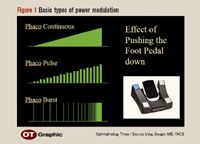Article
Total phaco energy minimized with changes in power settings, influences postop vision
Lisbon, Portugal—The use of ultrasonic phaco energy to emulsify cataracts has made surgeries safer and more efficient and has led to smaller incisions and better outcomes. Phaco energy, however, is also detrimental to the corneal endothelium, and the heat that it generates can lead to incision burns. In addition, the amount of phaco energy delivered directly influences the immediate postoperative vision.

In order to ensure an immediate return to sharp vision for cataract patients, while maximizing safety and efficiency, the phaco energy must be minimized. This can be accomplished by modulating the delivery of the ultrasonic waves via software on all major phaco machine platforms.

Basic versus advanced power
The basic power settings are continuous, pulse, and burst. In the continuous power setting, continuous energy is delivered with variable power depending on how long the foot pedal is depressed. In the pulse mode, the pulses of energy delivered have variable power, again depending on how long the foot pedal is depressed. The defining feature of pulse mode is that after each pulse of energy delivered, there is a period between increasing pulses of energy in which no energy is delivered-the "off" period. Alternating between the "on" and "off" pulse reduces heat and delivers half the energy into the eye.
Finally, in burst mode, each burst of energy has the same power, but the interval between each burst decreases as the foot pedal is depressed. The longer the foot pedal is depressed, the shorter the "off" period between each burst. As a result, at maximum foot pedal depression, the bursts of energy will create continuous delivery (Figure 1).
Although the basic power modulations are effective at decreasing phaco energy, they are also limited in their degree of programmability. Thus, with the hyper settings, an additional set of options can be programmed for the pulse and burst modes. For example, in the pulse mode, the rate can be as high as 120 pulses/second, compared with 20 pulses/second in the basic pulse mode. This gives the surgeon the feeling of continuous energy delivery or even the feeling of using a finely serrated knife during grooving if performing the divide-and-conquer technique.
Likewise, in the hyper setting for burst mode, each burst can be set as low as 4 msec, whereas in the basic power setting each burst had a lower limit of 30 msec. An additional feature in both pulse and burst hyper settings is the option of variable duty cycle and variable rise time for each packet of energy delivered.
Duty cycle
In the pulse mode, the default duty cycle is 50%. For instance, the pulse is on the "on" position 250 msec and "off" for 250 msec. The benefit of the new power modulation software is that the duty cycle can be changed, for example to 20% (10 msec on, 400 msec off, giving a ratio of 20:80). With a lower duty cycle, there is longer cooling time for the phaco needle, thus decreasing the amount of phaco energy delivered to the eye. In addition, during the "on" time, ultrasound energy is delivered with a jack hammer repulsion effect, while during the "off" time, no energy is delivered and nuclear fragments can be aspirated.
Newsletter
Don’t miss out—get Ophthalmology Times updates on the latest clinical advancements and expert interviews, straight to your inbox.




